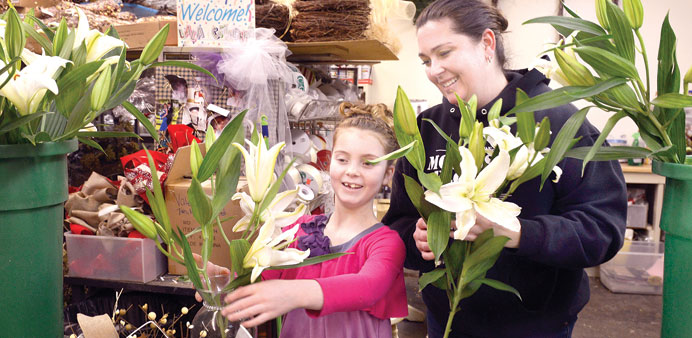By Joe Smydo
The first time the reddish colour appeared in Bella’s urine, Loren Carroto blamed the ice pops her daughter had eaten at a birthday party.
But the discolouration returned intermittently. It turned out to be blood, not food colouring, and the diagnosis was one affecting a growing number of children: kidney stones.
Five years later, Bella, now 9, remains on a low-salt diet, which helps prevent new kidney stones from forming but keeps her from eating many of the fast foods that kids love. “It’s a constant battle,” said her mother, who enforces the dietary restrictions.
Comprehensive studies have not been done, so estimates of the number of US paediatric kidney stone cases are unavailable. However, doctors say they are seeing more children with the ailment, and some hospitals, including Children’s Hospital of Pittsburgh of University of Pittsburgh Medical Center, have established special programmes to diagnose and treat it.
In the past year, Children’s saw about 100 patients who have had kidney stones, said Michael Moritz, clinical director of paediatric nephrology. Kidney stones are tiny mineral deposits that form in some people’s kidneys. If they remain there, they cause no pain, and a person would be unaware of them.
Trouble comes when a stone leaves the kidneys and travels through or gets stuck in the narrow urinary tract. Blood is one symptom; intense pain is another.
“It’s extremely, extremely painful,” Dr Moritz said, noting that some women have described kidney stones as being as painful as childbirth.
Looking back, Carroto said, it’s possible that Bella experienced stone-related pain that, at the time, she attributed to stomach viruses.
Kidney stones are roughly the same size in children and adults, but children’s organs are smaller, so they may have a more difficult time passing them, Dr Moritz said. If stones do not pass out of the body on their own, they may have to be surgically removed.
Because paediatric kidney stones remain an emerging trend, medical professionals may not be quick to suspect them, said Gregory Tasian, a paediatric urologist at The Children’s Hospital of Philadelphia. If physicians do suspect them, Dr Tasian said, they first should use ultrasound to look for them instead of other imaging tests that would expose young bodies to radiation.
In Bella’s case, neither a paediatrician nor emergency room doctor could pinpoint her problem. “Nothing showed up” on X-rays and other tests, Carroto said. Then she and her husband, Chad Carroto, took her to Dr Moritz, who diagnosed the kidney stones with the help of an ultrasound.
Marian Riggins said her daughter, Taylor, 7, began experiencing bloody urine in December 2013. Although doctors insisted Taylor had a urinary tract infection, the problem persisted, and Riggins challenged that diagnosis.
“I wanted somebody to listen to me because I knew something was wrong,” she said.
Riggins took her to The Children’s Hospital of Philadelphia, where Dr Tasian diagnosed kidney stones. In a year, Dr Tasian said, his programme treats about 500 patients, about 100 of them newly diagnosed.
Because they’ve been studied less than the adult condition, paediatric kidney stones are something of a mystery. According to an August 2011 article in the Clinical Journal of the American Society of Nephrology, children’s stones occur more frequently in girls than boys even though most adult cases affect men.
Dr Tasian said prevalence has increased so quickly over the past 25 years that environmental factors are more likely to blame than genetic causes. “Diet is a strong risk factor,” he said.
He and Dr Moritz said children by and large don’t drink enough water, which flushes stone-forming minerals from the body.
Nor, Dr Moritz said, do children eat enough fruits and vegetables, which have alkaline properties that counter stone production. On the other hand, kids eat too many fatty, salty foods and drink dark colas, which contain an acid that some doctors believe to be a factor in stone formation.
With Bella’s diagnosis, Carroto said, she had to increase her daughter’s water intake and limit her access to fast food and sodas. The challenge opened her eyes to the pervasiveness of salty, processed foods. When she realised how much salt was in chicken nuggets and other school-prepared meals, she said, she began packing Bella’s lunches.
Riggins said Taylor, whose sisters, Hannah, 13, and MacKenzie, 10, do not have kidney stones, has been a good sport about her own dietary restrictions. “She will be the first one to check something and say, ‘I can’t have it,’” said Riggins, who has introduced baby snacks and gluten-free foods to the household.
Dr Moritz said treatment at Children’s in Pittsburgh includes a metabolic analysis of the patient’s urine and a “targeted dietary approach,” while Dr Tasian said his program’s comprehensive approach includes a metabolic assessment and a team of nephrologists, urologists, dieticians and radiologists.
Carroto said she doesn’t know whether Bella passed her kidney stones, but her daughter, a soccer player who has taken medication in addition to watching her diet, has been symptom-free for a year and a half. “Prevention is the best treatment,” her mother said.
After having one stone removed, Taylor also is doing well. Dr Tasian, who saw no evidence of additional stones during a recent examination, said she’s “doing a tremendous job.” — Pittsburgh Post-Gazette/TNS

NO CHILD’S PLAY: Bella Carroto helps her mother, Loren, create a flower arrangement at the family business, Monessen Florist. Bella has paediatric kid


